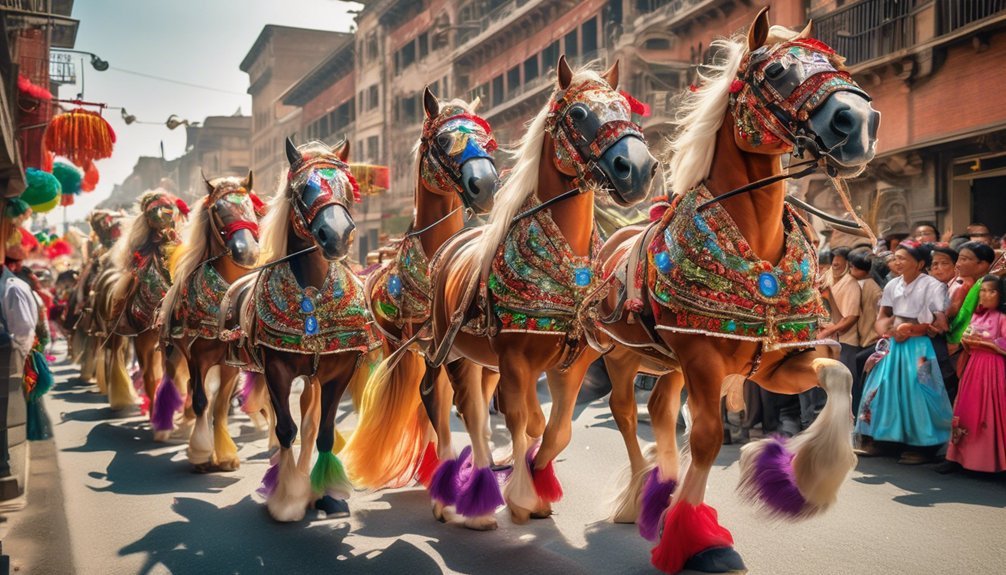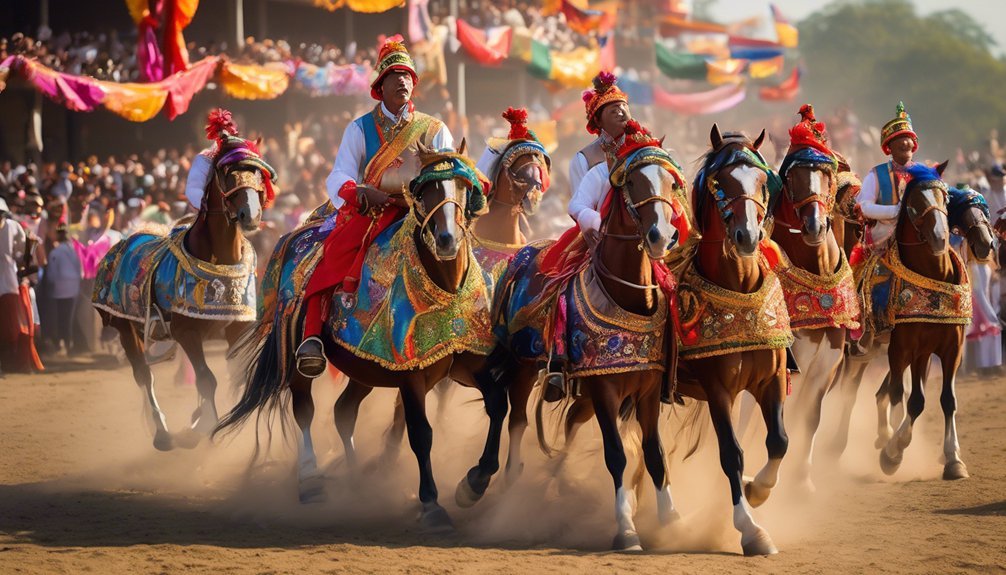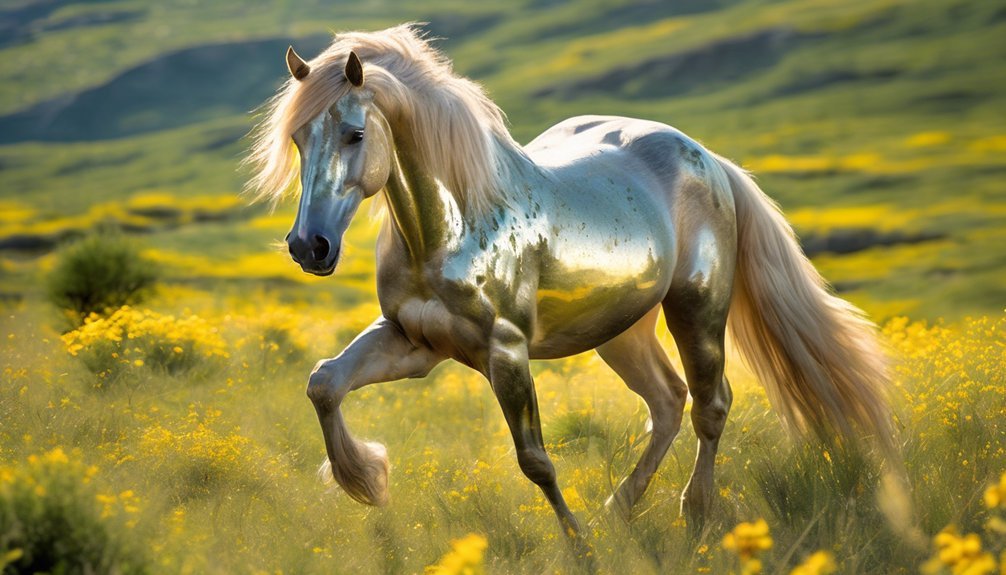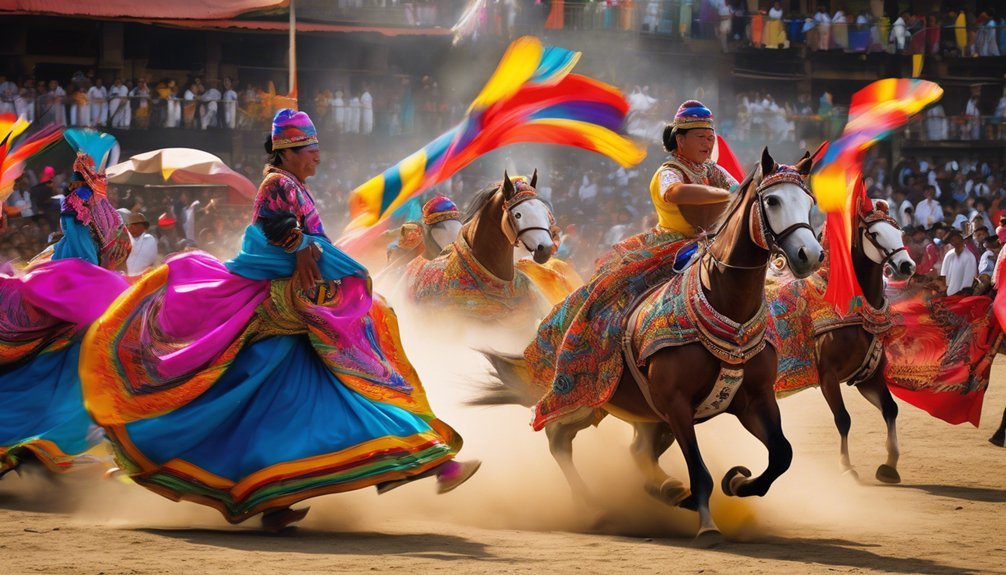
Did you know that horses have been integral to human celebrations for thousands of years, often serving as symbols of power and unity? Their majestic presence in parades and ceremonies isn't just for show; it reflects deep cultural values and historical significance. As you explore the fascinating ways horses enhance these events, consider how their roles shape not just the spectacle but also the connections between participants and their communities. What makes these majestic animals so vital to these traditions?
Key Takeaways
- Horses symbolize power and prestige, often serving as mounts for leaders during traditional ceremonies and parades, reinforcing status and authority.
- They enhance the ceremonial experience by captivating audiences, evoking emotions, and creating a shared sense of joy and connection among spectators.
- The bond between horse and rider is crucial, as trust and communication elevate the overall experience during ceremonial events.
- Training and preparation ensure horses are comfortable in bustling environments, reducing anxiety and promoting a smooth participation in ceremonies.
- Festivals featuring horses strengthen communal ties, showcasing shared cultural values and enriching the narrative of traditions through their majestic presence.
Historical Significance of Horses in Ceremonies

Throughout history, horses have played a pivotal role in various ceremonies, serving as symbols of power, grace, and connection to the divine. You'll notice their ceremonial roles in countless historical practices, from regal parades to sacred rituals.
In ancient cultures, horses often carried leaders into battle or during significant events, reflecting status and authority. The majestic presence of these animals not only captivated onlookers but also reinforced communal bonds during celebrations.
As you observe these moments, consider how horses embody the essence of tradition and spirituality. Their involvement in ceremonies transcends mere functionality; it speaks to humanity's enduring relationship with these magnificent beings, enriching cultural narratives and establishing a profound connection to our shared history.
Symbolism of Horses in Different Cultures
In various cultures, horses symbolize strength, freedom, and nobility, reflecting their roles in society and tradition.
You'll notice how mythology and folklore often elevate these animals to almost divine status, representing everything from war to wisdom.
Cultural Significance of Horses
While many animals hold symbolic value across cultures, horses uniquely embody strength, freedom, and nobility in various traditions. Their significance transcends mere utility, as they weave into the fabric of cultural heritage.
Consider their equine symbolism in these contexts:
- Warriors and Nobility: Horses often symbolize power and prestige, serving as mounts for kings and warriors in numerous societies.
- Spiritual Guides: In some cultures, horses are believed to carry souls to the afterlife, emphasizing their connection to spirituality and the divine.
- Community Bonding: Festivals featuring horses strengthen communal ties, showcasing shared values and collective identity.
As you explore these meanings, you'll recognize how horses continue to inspire and connect people across generations, reflecting deep-rooted cultural narratives.
Horses in Mythology and Folklore
As you delve into the rich tapestry of mythology and folklore, you'll find that horses often serve as powerful symbols, embodying various qualities unique to each culture. In many tales, they're not just animals but mythical creatures that represent freedom, strength, and nobility.
For instance, the winged Pegasus in Greek mythology symbolizes inspiration and the transcendence of the ordinary. In contrast, folklore heroes often ride horses that match their traits—think of the loyal steed accompanying a brave knight into battle, enhancing the story's depth.
Across cultures, these majestic beings bridge the earthly and the divine, illustrating humanity's connection to nature and the spirit world. Their symbolism invites you to explore the deeper meanings woven into our shared narratives.
The Bond Between Horse and Rider
The connection between horse and rider transcends mere functionality, evolving into a profound partnership marked by trust and mutual understanding. This bond isn't just felt; it's cultivated through intentional efforts.
To strengthen this relationship, consider these bonding exercises:
- Groundwork Sessions: Spend time leading and working with your horse on the ground to build trust.
- Body Language Awareness: Practice rider communication by observing your horse's reactions, enhancing your connection.
- Trail Riding Together: Explore new environments, allowing shared experiences to deepen your relationship.
Each interaction shapes your understanding of one another, reinforcing the idea that you're not just riding a horse; you're partnering with a sentient being.
Embrace this journey together, and watch the bond flourish.
Horses in Royal Processions
Horses have long held a place of honor in royal processions, symbolizing power and prestige. You can feel the energy as these majestic creatures, donned in exquisite royal attire, stride confidently along ceremonial routes. Their smooth movements echo the history of tradition, each step resonating with centuries of culture and ceremony.
You might notice how the horse's regality complements the pageantry of the procession, enhancing the spectacle for onlookers. The rider, often clad in equally impressive garments, embodies authority and grace, creating an inseparable bond between horse and rider.
As the procession unfolds, the horses become living symbols of the monarchy, captivating hearts and minds while reinforcing the importance of heritage in every majestic moment.
Local Festivals and Their Equestrian Traditions

While attending local festivals, you might notice how deeply rooted equestrian traditions are woven into the fabric of community celebrations.
These vibrant events often showcase the bond between horses and people, creating an atmosphere of joy and pride.
Here are three key elements that highlight this connection during equestrian parades:
- Colorful Costumes: Horses adorned in intricate decorations reflect the local culture, adding a visual feast that enchants onlookers.
- Traditional Music: The rhythmic sounds accompanying the parade enhance the festive spirit, uniting participants and spectators alike.
- Ritualistic Performances: Many parades feature choreographed displays, showcasing the skill and training of both horses and riders, captivating everyone present.
These elements make local festivals a heartfelt celebration of equestrian traditions, enriching community ties and preserving history.
Training and Preparation for Ceremonial Events
When preparing horses for ceremonial events, it's essential to focus on basic training techniques that build a solid foundation.
You'll notice that pre-event conditioning plays a crucial role in ensuring the animals are physically ready, while also learning to handle the stress of bustling environments.
Observing how these elements come together can give you a deeper understanding of the dedication involved in this traditional practice.
Basic Training Techniques
To ensure horses perform well during traditional ceremonies, effective training techniques are essential.
You'll want to focus on developing a strong foundation through groundwork exercises and desensitization techniques. These methods create a confident, responsive horse that's comfortable in various environments.
Here are three key techniques to incorporate into your training:
- Groundwork Exercises: Start with lunging and leading to establish respect and communication.
- Desensitization Techniques: Introduce your horse to different stimuli like flags or crowds gradually, reducing anxiety.
- Routine Practice: Regularly simulate the ceremony environment, so your horse becomes familiar with the sounds and sights they'll encounter.
Pre-Event Conditioning
After establishing a solid foundation through basic training techniques, the focus shifts to pre-event conditioning, which plays a significant role in preparing horses for ceremonial events.
You'll want to implement specific pre-event conditioning techniques that enhance your horse's physical fitness, ensuring they're not just well-trained but also in peak condition. Gradually increase their workload, combining endurance training with strength-building exercises.
Pay attention to their diet, ensuring it supports their energy needs leading up to the event. Incorporating varied terrains and obstacles during training can also boost their confidence and adaptability.
Observing your horse's responses during these sessions will help you fine-tune their regimen, fostering a deeper bond while readying them for the grandeur of the ceremony ahead.
Handling Stressful Environments
While preparing for ceremonial events, handling stressful environments becomes crucial for both you and your horse. Stress management techniques help ensure a smoother experience, allowing you to focus on the celebration.
Consider these strategies for effective environmental adaptation:
- Desensitization: Gradually expose your horse to the sights and sounds typical of ceremonies, from loud music to bustling crowds.
- Routine: Establish a consistent pre-event routine. Familiarity reduces anxiety for both you and your horse.
- Positive Reinforcement: Reward your horse for calm behavior during training sessions, reinforcing a sense of security.
The Impact of Horses on Spectators and Participants
Horses possess a unique ability to captivate both spectators and participants in traditional ceremonies, often evoking emotions that transcend mere observation. As you watch these majestic animals move gracefully, you feel a palpable energy in the air, enhancing spectator engagement. The sight of a well-trained horse can elicit awe, sparking shared moments of joy and connection among the crowd.
For participants, the experience is even more profound. Riding a horse during a ceremony is an intimate dance, blending trust and communication between you and the animal. This connection heightens your emotional investment, transforming a simple event into a memorable experience.
Ultimately, horses enrich the atmosphere, fostering a sense of unity that lingers long after the celebration has ended.
Frequently Asked Questions
What Breeds of Horses Are Commonly Used in Traditional Ceremonies?
You'll find that breeds like Andalusians and Clydesdales often grace ceremonies. Their cultural significance lies in majestic presence and strength; breed characteristics enhance the pageantry, creating an intimate connection between tradition and the horses that embody it.
How Are Horses Selected for Participation in Parades?
As you watch the rhythmic dance of horses in parades, remember that selecting them hinges on their temperament and rider compatibility. A calm spirit and mutual trust create a harmonious bond, captivating the audience's hearts.
What Are the Typical Costs Associated With Using Horses in Ceremonies?
When you consider the costs associated with using horses, you'll find horse leasing fees and transport expenses add up quickly. It's essential to budget carefully to ensure a smooth, enjoyable experience for everyone involved.
Are There Specific Care Routines for Horses Before Events?
Before events, you'll want to focus on grooming techniques and nutrition requirements. Regular brushing keeps their coat healthy, while a balanced diet ensures they're energetic and ready, making your preparations feel intimate and connected.
How Do Weather Conditions Affect Horse Participation in Ceremonies?
Weather conditions significantly influence equine behavior, so you'll need thorough weather preparation. Horses can become anxious or uncooperative in extreme heat or rain, affecting their performance and overall experience during ceremonies. Observing their reactions is crucial.
Conclusion
As the sun sets on the parade, the horses stand like sentinels of tradition, their hooves echoing the heartbeat of history. You feel the energy shift, a palpable connection between rider and steed, weaving stories of culture and unity. Each gallop is a brushstroke on the canvas of celebration, painting a vibrant picture of shared values. In this dance of power and grace, you realize that the spirit of the horse is not just seen; it's felt deep within.





